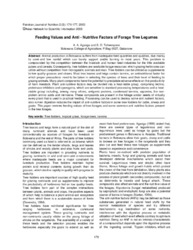| dc.contributor.author | Aganga, A. A. | |
| dc.contributor.author | Tshwenyane, S. O. | |
| dc.date.accessioned | 2020-09-11T08:59:36Z | |
| dc.date.accessioned | 2021-03-15T09:19:20Z | |
| dc.date.available | 2020-09-11T08:59:36Z | |
| dc.date.available | 2021-03-15T09:19:20Z | |
| dc.date.issued | 2003 | |
| dc.identifier.citation | Aganga, A. A., & Tshwenyane, S. O. (2003). Feeding values and anti-nutritive factors of forage tree legumes. Pakistan Journal of Nutrition, 2(3), 170-177. | en_US |
| dc.identifier.issn | 16805194 | |
| dc.identifier.uri | http://citeseerx.ist.psu.edu/viewdoc/download?doi=10.1.1.552.1801&rep=rep1&type=pdf | |
| dc.identifier.uri | http://moodle.buan.ac.bw:80/handle/123456789/281 | |
| dc.description | Journal article | en_US |
| dc.description.abstract | Animal production in Botswana suffers from inadequate feed quantities and qualities, due mainly to semi-arid low rainfall which can barely support arable farming in most years. This problem is compounded by the competition between the livestock and human feed industries for the little available pulses and cereals. Consequently, tree fodders are available forage resources which grazing herbivores can utilize without competition from monogastric animals and man. Tree fodders can be utilized as supplements to low quality grasses and straws. Most tree leaves and twigs contain tannins, an antinutritional factor for which proper precautions need to be taken in selecting the species of trees and their level of feeding to grazing animals. Many plant components have the potential to precipitate adverse effects on the productivity of farm livestock. Plant anti-nutritive factors may be divided into a heat-labile group, comprising lectins, proteinase inhibitors and cyanogens, which are sensitive to standard processing temperatures and a heatstable group including, among many others, antigenic proteins, condensed tannins, saponins, the nonprotein amino acids and mimosine. These compounds are present in the foliage and/or seeds of virtually every plant that is used in practical feeding. Processing can be used to destroy some anti nutrient factors, also rumen digestion reduces the impart of anti-nutritive factors in some tree fodders for cattle, sheep and goats. This paper reviews feeding values of tree forages and some common anti nutritive factors present in the tree forages. | en_US |
| dc.description.sponsorship | BUAN | en_US |
| dc.language.iso | en | en_US |
| dc.publisher | Asian Network for Scientific Information | en_US |
| dc.relation.ispartofseries | Pakistan Journal of Nutrition;Vol. 2 (3) 2003 | |
| dc.subject | Tree fodders | en_US |
| dc.subject | tropical grass | en_US |
| dc.subject | forage trees | en_US |
| dc.subject | tannins | en_US |
| dc.title | Feeding Values and Anti - Nutritive Factors of Forage Tree Legumes | en_US |
| dc.type | Article | en_US |

